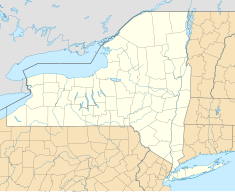| Ellis Island | |
|---|---|
 Aerial view of Ellis Island | |
| Location | Upper New York Bay Jersey City, New Jersey and New York City, New York United States |
| Coordinates | 40°41′58″N 74°02′23″W / 40.69944°N 74.03972°W |
| Area | 27.5 acres (11.1 ha) |
| Elevation | 7 ft (2.1 m)[1] |
| Built | 1900 (Main Building) 1911 (Hospital) |
| Architect | William Alciphron Boring Edward Lippincott Tilton James Knox Taylor |
| Architectural style(s) | Renaissance Revival |
| Governing body | National Park Service |
| Website | www |
| Official name | Statue of Liberty National Monument |
| Designated | May 11, 1965[2] |
| Official name | Statue of Liberty National Monument, Ellis Island and Liberty Island |
| Designated | October 15, 1966[3] |
| Reference no. | 66000058 |
| Official name | Statue of Liberty National Monument, Ellis Island and Liberty Island |
| Designated | May 27, 1971 |
| Reference no. | 1535[4] |
| Type | District/Individual Interior |
| Designated | November 16, 1993[5] |
| Reference no. | 1902 (district), 1903 (main building interior) |
Ellis Island is a federally owned island in New York Harbor, situated within the U.S. states of New Jersey and New York. Ellis Island was once the busiest immigrant inspection and processing station in the United States. From 1892 to 1954, nearly 12 million immigrants arriving at the Port of New York and New Jersey were processed there.[6] It has been part of the Statue of Liberty National Monument since 1965 and is accessible to the public only by ferry. The north side of the island is a national museum of immigration, while the south side of the island, including the Ellis Island Immigrant Hospital, is open to the public through guided tours.
The name derives from Samuel Ellis, a Welshman who bought the island in 1774. In the 19th century, Ellis Island was the site of Fort Gibson and later became a naval magazine. The first inspection station opened in 1892 and was destroyed by fire in 1897. The second station opened in 1900 and housed facilities for medical quarantines and processing immigrants. After 1924, Ellis Island was used primarily as a detention center for migrants. During both World War I and World War II, its facilities were also used by the US military to detain prisoners of war. After the immigration station's closure, the buildings languished for several years until they were partially reopened in 1976. The main building and adjacent structures were completely renovated into a museum in 1990.
The 27.5-acre (11.1 ha) island was expanded by land reclamation between the late 1890s and the 1930s and, at one point, consisted of three islands numbered 1, 2, and 3. Jurisdictional disputes between the states of New Jersey and New York persisted until the 1998 U.S. Supreme Court ruling New Jersey v. New York. The Supreme Court ruled that, while most of the island is in New Jersey, a portion of the northern end is an exclave of New York. The northern half of Ellis Island comprises the former Island 1 and includes the main building, several ancillary structures, and the Wall of Honor. The hospital structures on the island's southern half occupy the former sites of islands 2 and 3, and there is a ferry building between Ellis Island's northern and southern halves. Historically, immigrants were subjected to medical and primary inspections, and they could be detained or deported. The island is commemorated through the Ellis Island Medal of Honor, and it has received several federal, state, and municipal landmark designations.
- ^ "Ellis Island – Hudson County, New Jersey". USGS. Archived from the original on March 29, 2024. Retrieved January 1, 2011.
- ^ "Proclamation 3656 – Adding Ellis Island to the Statue of Liberty National Monument". April 5, 2010. Archived from the original on September 26, 2017. Retrieved April 3, 2010.
- ^ "National Register Information System". National Register of Historic Places. National Park Service. March 13, 2009.
- ^ "New Jersey and National Registers of Historic Places – Hudson County". New Jersey Department of Environmental Protection – Historic Preservation Office. Archived from the original on October 9, 2014. Retrieved August 2, 2014.
- ^ Ellis Island Main Building Interior Designation Report 1993.
- ^ "Overview + History | Ellis Island". Statue of Liberty & Ellis Island. March 4, 2020. Archived from the original on September 18, 2021. Retrieved September 10, 2021.




